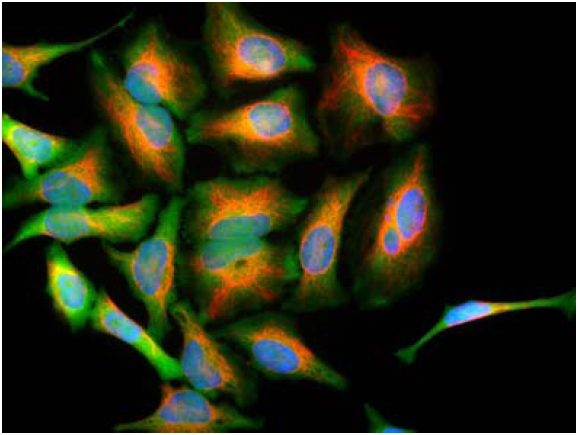Park7 (DJ-1) Antibody
Mouse monoclonal antibody
- SPECIFICATION
- CITATIONS
- PROTOCOLS
- BACKGROUND

Application
| WB, FC, IF |
|---|---|
| Primary Accession | O88767 |
| Reactivity | Bovine, Human, Mouse, Rat |
| Host | Mouse |
| Clonality | monoclonal |
| Isotype | IgG1 |
| Clone Names | 4H4 |
| Calculated MW | 21 KDa |
| Gene ID | 117287 |
|---|---|
| Gene Name | PARK7 |
| Other Names | Protein DJ-1, 34--, Contraception-associated protein 1, Protein CAP1, Fertility protein SP22, Parkinson disease protein 7 homolog, Park7, Cap1 |
| Target/Specificity | Full length recombinant human Park7 expressed in and purified from E. coli. |
| Dilution | WB~~ 1:2000 FC~~1:500 IF~~ 1:500 |
| Format | Affinity purified from tissue culture supernatant |
| Antibody Specificity | Specific for the ~21k park7 protein |
| Storage | Maintain refrigerated at 2-8°C for up to 6 months. For long term storage store at -20°C in small aliquots to prevent freeze-thaw cycles. |
| Precautions | Park7 (DJ-1) Antibody is for research use only and not for use in diagnostic or therapeutic procedures. |
| Shipping | Blue Ice |

Thousands of laboratories across the world have published research that depended on the performance of antibodies from Abcepta to advance their research. Check out links to articles that cite our products in major peer-reviewed journals, organized by research category.
info@abcepta.com, and receive a free "I Love Antibodies" mug.
Provided below are standard protocols that you may find useful for product applications.
Background
Park7, also known as DJ-1, is a member of the peptidase C56 family of proteins and is thought to function as a molecular chaperone. Mutations in park7 have been associated with autosomal recessive, early onset Parkinson’s disease (Bonifati et al., 2003). Recently, park7 has been shown to inhibit microtubule associated protein 1B aggregation thus leading to neuronal apoptosis (Wang et al., 2011).
References
Bonifati V, Rizzu P, van Baren MJ, Schaap O, Breedveld GJ, Krieger E, Dekker MC, Squitieri F, Ibanez P, Joosse M, van Dongen JW, Vanacore N, van Swieten JC, Brice A, Meco G, van Duijn CM, Oostra BA, Heutink P. (2003) Mutations in the DJ-1 gene associated with autosomal recessive early-onset parkinsonism. Science. Jan 10;299(5604):256-9
Wang Z, Zhang Y, Zhang S, Guo Q, Tan Y, Wang X, Xiong R, Ding J, Chen S. (2011) DJ-1 can inhibit microtubule associated protein 1 B formed aggregates. Mol Neurodegener. Jun 6;6:38
If you have used an Abcepta product and would like to share how it has performed, please click on the "Submit Review" button and provide the requested information. Our staff will examine and post your review and contact you if needed.
If you have any additional inquiries please email technical services at tech@abcepta.com.













 Foundational characteristics of cancer include proliferation, angiogenesis, migration, evasion of apoptosis, and cellular immortality. Find key markers for these cellular processes and antibodies to detect them.
Foundational characteristics of cancer include proliferation, angiogenesis, migration, evasion of apoptosis, and cellular immortality. Find key markers for these cellular processes and antibodies to detect them. The SUMOplot™ Analysis Program predicts and scores sumoylation sites in your protein. SUMOylation is a post-translational modification involved in various cellular processes, such as nuclear-cytosolic transport, transcriptional regulation, apoptosis, protein stability, response to stress, and progression through the cell cycle.
The SUMOplot™ Analysis Program predicts and scores sumoylation sites in your protein. SUMOylation is a post-translational modification involved in various cellular processes, such as nuclear-cytosolic transport, transcriptional regulation, apoptosis, protein stability, response to stress, and progression through the cell cycle. The Autophagy Receptor Motif Plotter predicts and scores autophagy receptor binding sites in your protein. Identifying proteins connected to this pathway is critical to understanding the role of autophagy in physiological as well as pathological processes such as development, differentiation, neurodegenerative diseases, stress, infection, and cancer.
The Autophagy Receptor Motif Plotter predicts and scores autophagy receptor binding sites in your protein. Identifying proteins connected to this pathway is critical to understanding the role of autophagy in physiological as well as pathological processes such as development, differentiation, neurodegenerative diseases, stress, infection, and cancer.




